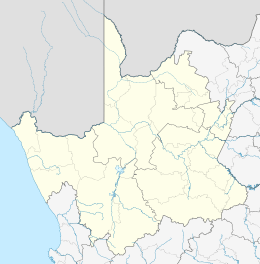Leliefontein, Northern Cape
| Leliefontein | |
|---|---|
|
Methodist Mission Church, Leliefontein | |
 Leliefontein  Leliefontein  Leliefontein
| |
| Coordinates: 30°18′00″S 18°05′00″E / 30.3°S 18.083333°ECoordinates: 30°18′00″S 18°05′00″E / 30.3°S 18.083333°E | |
| Country | South Africa |
| Province | Northern Cape |
| District | Namakwa |
| Municipality | Kamiesberg |
| Area[1] | |
| • Total | 0.67 km2 (0.26 sq mi) |
| Population (2011)[1] | |
| • Total | 616 |
| • Density | 920/km2 (2,400/sq mi) |
| Racial makeup (2011)[1] | |
| • Black African | 0.3% |
| • Coloured | 99.2% |
| • Indian/Asian | 0.3% |
| • Other | 0.2% |
| First languages (2011)[1] | |
| • Afrikaans | 95.8% |
| • English | 2.8% |
| • Tswana | 1.1% |
| • Other | 0.3% |
Leliefontein is a settlement in Namakwa District Municipality in the Northern Cape province of South Africa.
A village in the Kamiesberg Mountains, 18 miles (29 km) south-east of Kamieskroon, Leliefontein was established in 1816 by Reverend Barnabus Shaw, a Wesleyan missionary.[2] The mission was established on a farm awarded to the Namaquas by the Dutch governor Rijk Tulbagh.[3] It is probably named after the many white Lilies found in the area.[2]
It was the site of the 1902 Leliefontein massacre, during the final stages of the Second Anglo-Boer War.[4]
References
- 1 2 3 4 "Main Place Leliefontein". Census 2011.
- 1 2 "Leliefontein". Tracks4Africa Padkos. Retrieved 9 January 2014.
- ↑ Sandra Olivier (2005). Touring in South Africa. Struik. p. 169. ISBN 978-1-77007-142-1.
- ↑ "Leliefontein". Karoo Space. Retrieved 10 January 2014.
| Wikimedia Commons has media related to Leliefontein, Northern Cape. |
This article is issued from Wikipedia - version of the 11/3/2016. The text is available under the Creative Commons Attribution/Share Alike but additional terms may apply for the media files.
.svg.png)